Hello readers,
Just a quick note to let you know that The Denial File has moved and can be accessed by clicking this link.
We hope to see you over there!

Hello readers,
Just a quick note to let you know that The Denial File has moved and can be accessed by clicking this link.
We hope to see you over there!

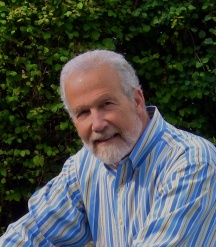
“Leucocephalus” Phil Hansten
In Dostoyevsky’s The Idiot, one of the least appealing characters is a fellow named Lebedev, a man who could pontificate on any topic. I was reminded of Lebedev following a recent discussion I had with a friend on the topic of climate change. My friend pointed out that, although he didn’t claim to understand the science of climatology, he did think Michael Crichton’s novels expressing skepticism about human-caused global warming made sense.
Now, to say Michael Crichton had remarkable talent and intelligence is a bit of an understatement. He graduated from Harvard summa cum laude, sold 200 million books, had colossal successes in television (ER) and film (Jurassic Park), and he won an Emmy, a Peabody, and an Academy Award. And this is only a partial list of his awards and accomplishments.
Unfortunately, however, therein lies the problem. People with that kind of success tend to have great difficulty in recognizing their limitations, and often have Lebedevian proclivities. Nobel Prize winners are notorious for this human foible. William Shockley (transistor) and James Watson (DNA), for example, both claimed there was strong evidence that some races were inherently less intelligent, despite overwhelming evidence to the contrary. Linus Pauling thought vitamin C could prevent many human ills. Other Nobel laureates have similarly ventured far afield to weigh in on topics about which they know very little.
Crichton apparently suffered from this same delusion… assuming that his astonishing success somehow allowed him to understand an exceedingly complex topic that was outside of his expertise. He was trained as a physician, not a climate scientist, and his skeptical views on climate change were thoroughly debunked by qualified climatologists. Crichton weighing in on the science of climate change makes about as much sense as me weighing in on quantum mechanics; I simply do not have the requisite training or understanding.
It would appear that people who pontificate on issues outside their field suffer from a humility deficiency. They would have no doubt profited from reading sixteenth century French thinker, Michel de Montaigne. Notoriously humble despite his obvious wisdom, Montaigne talked about how he eschewed topics about which he knew little: “…sounding the ford from a good distance; and then, finding it too deep for my height, I stick to the bank.” Would that Shockley, Watson, Pauling, and Crichton had the wisdom to stick to the bank as well.
Crichton was also vindictive; when a columnist criticized him on the climate change issue, Crichton put the columnist in a new novel as a pervert with a small penis who raped a 2-year-old boy. Not cool. It takes a pretty small person to do something like that rather than to debate the person who disagreed with him in an open forum. (I assume my criticism will not result in a similar fate for me since Crichton is no longer with us.)
Crichton had every right to question the findings of climatologists, of course. The problem is that—although he did not have a deep and nuanced understanding of climatology—his fame gave him a voice in the world that was orders of magnitude louder than that of those who are truly qualified: climatologists. And that is problematic for one simple reason… probability. It is overwhelmingly more probable that the climatologists are correct than that Crichton was correct.
Look at any scientific discipline during the past century; it is not unusual for people outside the discipline to snipe at the scientists within the discipline. On exceedingly rare occasions, the outsiders turn out to be more right than the scientists. But the question for the climate change issue is whether we are willing to bet the farm on the very slim chance that the climate change deniers are right. Basing public policy on the pronouncements of climate change deniers is like society putting all its money on a single number in roulette; we might win, but it is much more likely that we will lose big.
Mark Twain once said, “Supposing is good, but finding out is better.” Michael Crichton “supposed” that climate change does not represent an existential threat to humanity. But he did not “find out” if his position was scientifically valid. It wasn’t.
Blaise Pascal’s observation is again apropos: “So let us work on thinking well; that is the principle of morality.” The list of “not thinking well” on climate change is long: Michael Crichton, Fox News, most of the Republican candidates for president, fossil fuel corporations, a billionaire brother team (who shall remain nameless, lest I have to buy one of those mirrors to check under my car every morning), and countless “regular folks” who believe the propaganda spewed by the aforementioned voices. According to Pascal’s calculus these people are not thinking well and are taking an immoral position on a vital public policy question. In my opinion, Pascal is absolutely right.


“k1f” Kirby Farrell
If you’d like to be rescued from death, vote for me.
That’s the gist of a video clip Huffington Post put on Facebook. In it a presidential contender promises prospective voters in a New Hampshire tavern that he favors treatment for addiction. Within a day or two, more than two million people called attention to the clip. Whew.
Pundits at opposite ends of the spectrum praised the candidate’s pledge to favor treatment over punishment for addiction. Although treatment would cost money and conservatives loathe Medicare and Obamacare, a conservative blog called the candidate’s plea “riveting stuff,” and promised that “You won’t be able to take your eyes off of it.”
What makes the video spellbinding? For one thing, at a time when marketing strategists have reduced politics to bumper sticker slogans, the candidate ruefully describes his mother’s addiction to cigarettes and her eventual lung cancer in her 70s. Then he issues a challenge: nobody said, “Well, she deserved it, let’s not give her chemotherapy.” So why do so many people object to giving treatment to drug and alcohol addicts?
He values his mother’s life, he vows, as he values the lives of all addicts— and also babies saved from abortion. No doubt the candidate brought in abortion because it’s a hot button issue for conservatives. But there’s more to it than that.
Everyday prejudice assumes addiction to be mostly a problem of minorities and the shiftless poor. For decades, money that could have paid for treatment instead built prisons to punish drug offenders, especially black males. The moral aggression was deliciously logical. They got what they deserved. Likewise, when gays succumbed to AIDS, some conservatives eased their fear by scolding that They deserved it.
It’s almost a reflex: when frightened, turn flight into fight. Attack and punish the threat. If you assume free will is always more powerful than physiology, you can blame the victim for irresponsible risk-taking.
In the video the candidate urges us to think of Mum and be more sympathetic. Not to seem sentimental, he then recounts how a fabulously successful lawyer he knew became addicted to Percoset, lost his ideal wife, family, and house, and died in a motel room with a bottle of vodka and an empty bottle of Percoset. It’s death: total failure. At the funeral the candidate saw the man’s three daughters sobbing. Again he pledges to support treatment for addiction. The lawyer wasn’t weak or irresponsible, he’s a victim.
To be fair, the candidate sounds sincere. Yet these sob stories are moves in a political campaign. They have a mythic quality. The heroic leader pledges “treatment” to save victims of a runaway appetite from death. In the process he absolves them of guilt. In the real world of course, treatment is helpful but no panacea. What matters in the video is that the hero wants to help.
Who wouldn’t want to be rescued? The wish goes back to childhood and the dream of omnipotent parents. It implies a fear of failure, chaos, and social death. And it puts the supplicant in the role of a guilty child grateful to a big-hearted parental patron.
The candidate was taking a risk, because the conservative base doesn’t approve of government solutions to problems. Yet here’s the screaming irony: the money the candidate pledges for treatment would be public money. It already belongs to the listeners. They’ve paid for it in taxes and fees. In effect, they’ve pooled their money in an insurance fund that could treat addiction and other illnesses. The problem is that propaganda diverts public money to the corporate military or tax breaks for the grateful rich.
Rather than ask who would oppose treatment for addiction, the candidate spins a yarn about Mum and his tragic lawyer friend. This also masks the public reality. After all, an affluent lawyer leading a conservative life doesn’t need public money: he can pay for his own treatment. And if treatment didn’t work in his case, was something wrong or missing in his ideal inner life?
As it happens, as the governor was offering to rescue voters, two economists released a study that finds “Death Rates Rising for Middle-Aged White Americans.” In fact, “Unlike every other age group, unlike every other racial and ethnic group, unlike their counterparts in other rich countries, death rates in this group have been rising, not falling.” Who’s affected? Primarily whites 45 to 54 years old with no more than a high school education. The cause? Not “the big killers like heart disease and diabetes but an epidemic of suicides and afflictions stemming from substance abuse: alcoholic liver disease and overdoses of heroin and prescription opioids.”
In a word, stress is up, incomes are down, and your job has gone to China. In the period covered by the study, “the inflation-adjusted income for households headed by a high school graduate fell by 19 percent.” As belts tighten, you have less control over your life. Reach for the painkillers.
Whether out of dumb luck or shrewd intuition, the candidate offers to rescue troubled whites just as prisons and wars against drugs are finally revealing their cruelty and futility. Even more serendipitous: pundits praised the video because the candidate was dying in the polls, and his “emotional plea” seemed to revive his prospects. Everybody likes a story about an underdog beating the reaper and rewarded for his humanity.
Why did the video catch so much attention? It’s likely that in an era of predatory money, people are excited to see someone on top showing compassion. While the workaday world touts survival of the fittest, the video suggests we can pull together. We’re social animals. We want to believe.
How real is the candidate’s compassion? Hard to say. He sounds sincere. Maybe his near death in the polls made him sympathetic to others in trouble. At least he’s proposing help rather than another enemy to bomb. Tome his empathy would be most convincing if he openly disagreed with opponents who want to divert the public’s money to the rich and hungry. With living standards under pressure, he could even pledge to relieve stress on working folks, addicted or not.
Let me know when that video turns up.
********************************************
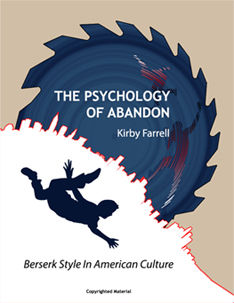
In slang we talk about flipping out, running amok, losing it, etc., Berserk abandon is terrifying yet also alluring, since it promises access to extraordinary resources by overthrowing inhibitions. Berserk style has shaped many areas of contemporary American culture, from warfare and business to politics, sports, and intimate life. Focusing on post-Vietnam America and using perspectives from psychology, anthropology, and physiology, Farrell demonstrates the need to unpack the confusions in language and cultural fantasy that drive the nation’s fascination with berserk style.
0 0 0
<<This book amazes me with its audacity, its clarity, and its scope. We usually think of ‘berserk’ behaviors—from apocalyptic rampage killings to ecstatic revels like Burning Man—as extremes of experience, outside ordinary lives. in fascinating detail, Farrell shows how contemporary culture has reframed many varieties of abandon into self-conscious strategies of sense-making and control.
Abandon has become a common lens for organizing modern experience and an often troubling resource for mobilizing and rationalizing cultural and political action.This landmark analysis both enlightens and empowers us.>>
—Les Gasser, Professor of Information and Computer Science, U. of Illinois, Urbana-Champaigne.


“k1f” Kirby Farrell
We’re social animals, with an instinct for group competition that’s evolved to intensify solidarity, as in team spirit. Cooperation to win makes the group stronger and insures survival. Heroes, families, and tribes compete in order to expand, lead, and dominate others. In civilization, where strangers live together, the emphasis is usually on team sports that act out warfare without the bloodshed.
In rampage killing, the symbolic quality of sport breaks down. Opponents become enemies. Defeat means death. Almost all rampage killers role-play the warrior-hero. When they dress in combat fatigues and use military weapons, psychiatry calls them pseudo-commandos. They convince themselves they’re revenging or rescuing what’s right. Police said the killer in Oregon had “a philosophy of hate,” as did Dylann Roof murdering black churchgoers, and Anders Breivik in Norway. A neighbor of the Roseburg killer reports that, “The way Chris [Mercer] carried himself was like ex-military almost—combat boots, camo pants, white shirt, brown shirt. Every day it was the same thing.” As in a war, he had body armor and was “armed for a long gunfight.”
Whatever the motive, why does rampage take the predictable form of an indiscriminate assault with guns blazing? Why this model and not another? Yes, American culture is awash in guns and heroic, paranoid stories about vigilante guns saving lives. Military weapons are readily available. And in the most expensively militarized country in history, about half of rampage killers have had military training—far more than ordinary murderers. Headline news and movies provide lavish models to follow.
All these tools presuppose a split world organized around us—or me—versus them.
Football games sometimes injure or kill the players, but part of the thrill of the game is the effort to temper do-or-die fury with skillful restraint. With a gun, a rejected player can dictate a new game and take a starring role. The wannabe hero competes with innumerable opponents, which raises the stakes and tactics to survival pitch.
Most rampage killings have a copycat quality. The Columbine killers frankly aimed for record-breaking infamy that would compel Hollywood and cow the world. They were competing for heroic celebrity. If you’re depressed or aggrieved or frightened of your own insanity, as Adam Lanza was in the Sandy Hook school savagery, the wish to be a “big man” can be irresistible. It shows up in the fascination with Hitler and Satan and messianic heroes. They’re superhuman masters of life and death. In shooting Rep. Gabrielle Giffords, Jared Loughner imagined he was saving the nation. As in terrorism, the violence can end in suicide, yet death in a blaze of glory can seem more alluring than an insignificant life without meaning.
What these behaviors have in common is the berserk belief that if you free yourself of all inhibitions, you can get access to amazing powers. Running amok, you feel pumped up, beyond taboos and doubts, indifferent to pain and death. You risk suicidal chaos, yet abandon generates a nervous system rush that feels superhuman. With weapons blazing, the warrior role enables you to run free, mowing down opposition, for a touchdown.
But here’s what we often overlook: rampage killers dream of heroic domination so overwhelming that they can command the world’s respect and abject reverence. The rampage is a nightmare demand to belong.
The Oregon killer sympathized with rampage killers such as Vester Lee Flanagan, because “he was all alone and unknown, yet when they spill a little blood, the whole world knows who they are.” His conclusion? “Seems the more people you kill, the more you’re in the limelight.” In another entry he commented: “People like [Flanagan] have nothing left to live for, and the only thing left to do is lash out at a society that has abandoned them.” What he calls “limelight” is the glow of belonging and the spotlight that confirms you exist and you matter. The terror is to be alone and in effect dead.
Conventional wisdom imagines berserk fury to be out of control. But in fact, as copycat rampages demonstrate, you can manipulate the fantasies and physiology. Like James Holmes in Aurora Colorado, and Adam Lanza, the Roseburg killer was on the edge of control but also planning record-breaking devastation, as he signaled on an anonymous chat-room the night before. Chris Mercer was a student at the community college, desperately uncomfortable with others and desperately unhappy. It seems likely that he murdered other students because to him they represented a rival team—and rivals who were winning.
Berserk abandon is not some rogue pathology. In fact, it is all around us today. When bungee jumpers plunge into a chasm, they are role-playing at suicide. Their calculated abandon is a form of play-death and rebirth. Rebounding, the jumpers feel more keenly alive and fearless. Pumped up to emergency levels, the nervous system reinforces a conviction of resources beyond humdrum everyday limits.
Countless American movies are fantasies of abandon. Bullets and bodies fly, but the hero emerges unscathed to claim the girl and a fertile future of more life. When this plot gets boring, the quest for more thrilling extremes becomes self-intoxicating. In an age of digital effects, the studios’ competition to develop ever more convincing mayhem becomes part of a movie’s story and a selling point.
Since WW2, and even more so since 9/11, Americans have been cultivating abandon as a style. If you have history’s most expensive military, why not use it. Every quarrel acquires do-or-die urgency. Propaganda demonized Saddam Hussein, and now the “shock and awe” invasion of Iraq has created the nightmare of ISIS, historic refugee panic, and widespread chaos in the Middle East. This is a gunfighter mentality gone amok.
In its deregulated speculation, Wall Street took extraordinary risks, endangering global finance. To score points with excited partisans, politicians look for excuses to shut downgovernment. The same dynamics appear on a personal level in binge behavior from drug use to gambling. The allure of abandon promises to turn anxiety and depression into adrenalized potency, as in rant broadcasting’s focus on “enemies” in order to enjoy putting them down.
Underlying all such berserk righteousness is survival anxiety. Soldiers run amok facing literal death. But social death can be just as powerful. To lose face, lose hope, and to lose your mind to mental illness can also be a form of death. You can see death-anxiety behind the struggle over health insurance, in fantasies about “death panels.” A Tea Party rally audience “Cheered [the] Idea of Letting Uninsured patients Die” (ABC News,13 Sept.11). In such examples people focused on fears of victimization, then fantasized about aggression. Berserk style makes “take no prisoners” thinking seem natural and even heroic.
Guns may be the chief marker for the berserk mentality. After a rampage, gun sales surge “as buyers express fears that politicians may use the shootings to seek new restrictions on owning weapons” (AP, 25 July 12). The purchasers want to be able to kill in a pinch. Never mind that data shows that guns bought for self-defense are likely to kill the wrong people. Never mind the childish NRA fantasy that pictures gun-owners as dead-eye vigilantes killing insane killers.
Like Dylann Roof’s murder of black folks at prayer in a church, and like the cops photographed murdering black men, panic is explosive and labile. When panic and rageare confirmed, the hysteria is indiscriminate. American Christian lynch mobs did unspeakable things to their victims. Demagogues today cunningly press one hot button after another: immigrants, abortion, nigger rapists, terrorists—tools to push people to an emergency pitch.
The psychology of abandon recognizes that all these behaviors show our instinct for group protection and power. Rampage killers regularly kill to attack a hated group on behalf of some real or tacit group. Sometimes they identify with other rampage killers as if they form an army of “buddies.” Even isolated, they behave as if “my side” is triumphing over “them.” Psychotic or not, they can act as if their rampage has the “as if” quality of a football game: warfare in which the feelings are intensely real and yet death is only symbolic.
After the Oregon rampage, President Obama reasoned on television about the need for gun control. Some spectators cheered the message. But you can be sure that those who openly despise the mixed race president felt gut hostility to his appeal: a virtual fight with the president and with his “fans.” Civilization is a football game that excited strangers can attend without confusing numbers on a scoreboard with an enemies list. When the game leaves some players face down and bleeding on the field, it’s time to reexamine team spirit.
************************
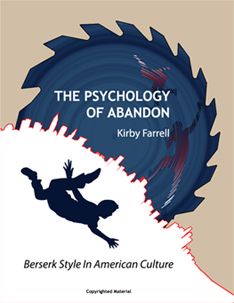
The psychology of abandon studies borderline behavior and emergency physiology. In slang we talk about flipping out, running amok, losing it, etc., Berserk abandon is terrifying yet also alluring, since it promises access to extraordinary resources by overthrowing inhibitions. Berserk style has shaped many areas of contemporary American culture, from warfare and business to politics, sports, and intimate life. Focusing on post-Vietnam America and using perspectives from psychology, anthropology, and physiology, Farrell demonstrates the need to unpack the confusions in language and cultural fantasy that drive the nation’s fascination with berserk style.
<<This book amazes me with its audacity, its clarity, and its scope. We usually think of ‘berserk’ behaviors—from apocalyptic rampage killings to ecstatic revels like Burning Man—as extremes of experience, outside ordinary lives. in fascinating detail, Farrell shows how contemporary culture has reframed many varieties of abandon into self-conscious strategies of sense-making and control.
Abandon has become a common lens for organizing modern experience and an often troubling resource for mobilizing and rationalizing cultural and political action.This landmark analysis both enlightens and empowers us.>>
—Les Gasser, Professor of Information and Computer Science, U. of Illinois, Urbana-Champaigne.

In a supermarket the other day I noticed an attractive young woman and then, with a shock, her right hand. With a mix of fascination and anxiety I saw that the hand was a stump with a thumb and, where her pinkie should have been, a middle finger opposing her thumb like a pincer.
Intellectually I wasn’t startled at all: birth defects happen all the time. Every pregnancy is a fabulous storm of genetic information shaping the growing fetus. Not surprisingly, messages occasionally get misdelivered, mutated, or scrambled. Such variability makes evolution possible. In every family of puppies or kiddies, the individuals have a different mix of traits. You may recall the famous Russian ethologist who mated the tamest individuals from different litters of Siberian foxes and eventually produced two different animals: the usual ferocious fox and new foxes tame as a lapdog, with juvenile (neotenic) physical and behavioral traits.
Some genetic variations turn out to be adaptive, some crippling or even fatal: some more or less irrelevant. What surprised me in the supermarket was the fascination and twinge of anxiety I felt at the sight of the young woman’s peculiar hand. Unless she wanted to be a pianist, the mutation presented no serious obstacle to an effective life. Yet its strangeness had an uncanny quality, and I could see why the woman casually kept the hand covered around strangers.
What’s going on here?
We’re psychosomatic(link is external) creatures. We generate our conception of reality by combining feedback from our bodies, parents, and cultures. In learning particular rules and facts (The stove is hot, don’t touch it) we’re also developing categories that enable us to judge new things by relating them to what’s already familiar (hot, cold; pleasure, pain, etc). In thewisdom of slang we learn by “absorbing” or rejecting new anomalies that don’t fit what we already know. The more you can absorb, the wider we say your knowledge of the world—your experience—is.
Meanwhile back in the supermarket, there I am puzzled by the fascination and anxiety the unusual hand stirred in me. Fascination is an emergency response to something unexpectedly new. Confronted by a potentially good or dangerous anomaly, fascination focuses and concentrates your attention.
Attractive people promise more life. Movie “stars” or pumped up body “builders” invite hero-worship—transference. They look more or less like other humans, but their exceptional features have the quality of fetishes. Like money, religious symbols, or the flag, their beauty or strength has power we identify with.
At root, the power we imagine in positive anomalies seems to offer more life, and more life means less insecurity, less danger, less death. Attractive young people signal fertility, a long life ahead of them. Idealizing them, we can attribute all sorts of talents and virtues to them. In a supermarket this is especially pronounced. The store is a temple of symbolic immortality. You gaze at blood-red animal cuts, fun sweets, and lively packaging. Everything is “king size” or “super.” Mr Clean will wash away dirt, disease, and death. In panting color the magazine rack presents “out of this world” hair styles and invincible new cars. In the freezers food is imperishable, and in the pharmacy life can be rescued from decay.
In such a fantasy world a birth defect is jarring. Since we’re highstrung, vulnerable animals, with radars always scanning the horizon for threats, we’re apt to feel—hello—anxiety.
Anomalies show that the world is bigger and stranger than “our” reality. Even anomalies that promise more life rattle us, but in that case we interpret our response as positive “wonder” or as the kids say, “awesome.” By contrast, anomalies that threaten to limit or impair life remind us that our bodies are fragile and impermanent. They arouse associations with injury, futility, and death. And such a response is especially disturbing because often it’s a gut response, not a conscious judgment that allows us to feel smart and masterful.
As Michael Polanyi(link is external) reminds us, never mind Freud, most of the time we don’t know why we react as we do. A strange face may strike you as appealing or repellent. You recognize the new visage as a gestalt:(link is external) you don’t analyze lips, chin, eyes, and other features to assemble your concept. Like the uncanny answer to a riddle, the face clicks into awareness, often making a positive or negative impression. You’ve unwittingly processed the information before you come up with a conscious account of the face. You know more than you can say.
But that’s not all. The gut reaction to an anomaly is usually characterized bymoral aggression. You “fight” a “bad cold”; genetic variations are birth “defects” or “abnormalities.” The fear is that otherwise the anomaly will contaminate or infect you. In the wisdom of slang, what’s surprising threatens to “freak you out.” Much of the time an anomaly may be harmless or even beneficial, but as in paranoia, we feel it has a menacing quality. If you misjudge an anomaly, you may be using it as a scapegoat, blaming it for faults that really lie elsewhere. It is easy to scapegoat immigrants and other races, for example, exaggerating superficial differences. Gut-level self-defense can turn them into abnormalities. Your hostility may be scarcely conscious yet it pumps up the nervous system’s emergency chemistry as well as righteous self-esteem.
It’s useful to see that the negative, even evil associations we attribute to some anomalies are delusions. They’re grounded in our nervous systems and the false categories culture has taught us. Our reactions are prejudiced, based not on evidence but on limitations in the way we’re built. In a classic experiment monkeys panicked when shown the severed head of a monkey. The severed noggin was actually harmless, but the monkey subjects weren’t assessing the evidence, their shock was instinctual. They reacted as you and I react when terrorists behead a human captive.
Civilization means living arrangements that allow strangers to live together. And the awkward truth is that other people are always anomalies. Civilized imaginations have to keep getting used to anomalies. One way is to think of them as variations or exceptions rather than defects, or as a new opening to be explored . Ultimately tolerance comes from recognizing that though we often cling to cherished categories like a child’s safety blanket, reality is variations in motion, not a polished rock.
Prejudice isn’t just about racism or hating broccoli. It’s what happens when your gut reaction to the strangeness of being alive starts to panic. Think of the common cold that stuffs your head with moldy dishrags and spills sand into your windpipe and lungs. What causes that misery isn’t the cold virus—the anomaly—but your immune system’s overreaction.
Luckily we’re singularly adaptable animals. We can play, experiment, and teach each other what’s good for you and what gives you poison ivy. We can share our curiosity and discoveries—which you and i are doing right now. Yes, some anomalies are really hard to get used to, such as the kind of rogue asteroid that made the dinosaurs late for breakfast. Closer to home are the surprises that you meet in your local immortality emporium, between Mr Clean and the can opener with the lifetime guarantee: a surprise that helps you wonder who we are.
* * *
Resources used in this essay:
Michael Polanyi: The Tacit Dimension
Ernest Becker: Escape from Evil


“k1f” Kirby Farrell
Spoiler alert!
If a story can be spoiled by knowing “the ending,” then the ending is likely to be an entertaining surprise, the answer to a puzzle or the punchline of a joke. If the surprise comes to you like the flash answer to a riddle, bringing closure, then it seems to come from intuition or “the unconscious” or magic. But the spoiler alert is warning us that the surprise has the contrived quality of a trick. Once you know it, it’s dead.
It’s schtick.
The Yiddish term schtick describes an easy, crowd-pleasing routine that usually has a clichéd or gimmicky quality. We’re ambivalent about schtick. It can be a habit that makes life gratifyingly easy. You sign off with a smiley face or xxxx kisses although that schtick could mean anything from “Have a nice day” to a heartfelt “I love you.” The cliché is boilerplate, a rubber stamp: a cut-&-paste substitute for more personal or even intimate meaning. As schtick, the sign-off allows you to enjoy a facsimile of closeness. It’s also a labor-saving device, sparing you the sweat or anguish of deciding how you really feel about this relationship at this moment.
In a world overloaded with information, schtick can function as a code. It’s a kind of abbreviation or shorthand. You know what to expect, you don’t have to ponder it, test it, taste it, keep coming back to it. You don’t have to pay attention to details or read the whole thing. This gives you more time to enjoy more schtick.
Fast food is schtick. Most pop music is schtick. Industrial entertainment (TV, Hollywood, social media) relies on schtick. Think of the fights or explosions that climax thrillers. Bullets and fists fly, yet the heroes emerge triumphantly unscathed. Even romances build in a climactic kiss that resolves canned conflicts in a happy-ever-after ending. Advertising is often schtick making fun of schtick.
You can see where schtick shares some virtues of the factory. Identical products manufactured in scale are cheap and familiar. Once programmed, machines make production almost effortless and widely available. What’s not to like?
One complication is we’re pretty ambivalent about factories because they regiment, routinize, and depersonalize life. Schtick looks like “real life,” but you don’t have to take it seriously. It offers closure yet it doesn’t really resolve anything. Formula crime shows solve every crime. Nobody asks where crime comes from or what becomes of criminals after jail, or what happens to their families. In comedies, laugh tracks cue you to share in a nonexistent group’s hallucinatory merriment. The experience may be enjoyable, but like the popcorn box, you pitch it when the lights come on.
It’s a trick of course. Schtick is always going dead. Today’s schtick is tomorrow’s stale formula, so producers have to keep goosing it up to make it seem fresh. Yesterday’s climactic fistfight is today’s disemboweled loser or Los Angeles exploded by aliens, intestines slung in trees like holiday ornaments.
In this respect schtick is a kind of play. As in play, you know it isn’t true, but you behave for the moment as if it is. Here’s the catch: play as entertainment is different than play as exploration or experiment. A formula surprise isn’t the same experience as a discovery. A surprise is a product manufactured for you to use, whereas you have to make the discovery.
It follows that schtick is wish-fulfilling, even flattering. The customer is always right. Literature, by contrast, poses questions that sail off into the unknown, and dramatize suffering, hilarious absurdity, and death. Shakespeare’s Sonnet 18 asks, “Shall I compare thee to a summer’s day?” Nah. That would be schtick. His plays don’t really resolve. They explore. In the end characters go offstage to puzzle over the disruptive merriment or horrors we’ve just witnessed. The plays open out into the strangeness of being alive.
Most novels and commercial films rely on schtick—editors think of it as the hook. Writers are under terrific pressure to honor sctick. A recent prizewinning novel, Atticus Lish’sPreparation for the Next Life, describes the relationship of a vet suffering PTSD (Skinner) with an illegal immigrant (a Uigher woman named Zhou) who barely survives in NYC doing scut work. It’s a serious story, full of eloquent, brilliantly detailed descriptions of urban squalor. In the end the vet kills a monstrous ex-con who’s tried to rape Zhou and then shoots himself. The stricken Zhou lights out for the territory and ends up contentedly working on a ranch.
Here’s the catch: the novel vividly evokes the characters’ misery, but neither of them is capable of abstract thinking. Remember: it’s PTSD and an Asian woman with minimal English. The result is that the action is intense but the characters have almost no inner life. When you want to see what they’re thinking and feeling, brilliant pictures of the soulless city take over. The characters show little ambivalence or resistance to fatality, so the fatality they face seems plot-driven, and the ending contrived.
The novel dramatizes insistent themes in American culture these days: victimization, deadening work, vulnerable immigrants, callous government, damaged warriors, plucky women survivors, and sexual predators, to name a few. What’s eerily missing is inner life. Lots of grime, no imaginative sympathy in sight. The author and fans could reply that Well, that’s how American life is now. A society of cyborgs and ATMs. People talk schtick and self is no more than a logo on a sweatshirt. And yes, it can feel that way. But you could make that complaint about any era in history.
And more crucial still: values don’t pop out of manholes. Somebodies create them. Even when we fail or get it wrong, we’re always imagining values. It’s how we’re built
One sign of a cultural shift away from stories about inner life is the visionary sweep of soap operas such as The Sopranos, The Wire, or Rome. Their characters proliferate rather than develop in depth, but the scripts argue that that’s the effect of looking at a complex, big world. When it works, it’s powerful. It’s an epic perspective, an effect, you might say, of the globalized Information Age, where you get to know a tiny bit about a million people. Nothing is wholly exotic anymore and your “mobile device” can bring up Uighurs playing kickball in China, quantum diagrams, and flyby Pluto.
We’re ambivalent about this overwhelming scale of awareness. It excites our curiosity and fantasies of escape and apotheosis. But it also shows us how ephemeral we are. We see that universe of information in snapshots of schtick. One fistfight and kiss after another. On this gameboard everybody’s a helpless victim. Inner life seems depleted, waiting for some leader or story to pump it up again. Meanwhile schtick offers merchandized tattoos, “selfies” and “selfie sticks”—Don’t leave home without one.
After all, it isn’t the quantity of inner life we miss—who doesn’t know self-absorbed people? It’s the quality that matters. Something in us aspires to “get real” despite the warnings that life Contains Spoilers.
********
PS: it’s liberating to be able to spot when something is schtick and not the real thing. If you have an example, send it along. Let’s collect some tricks and kicks.
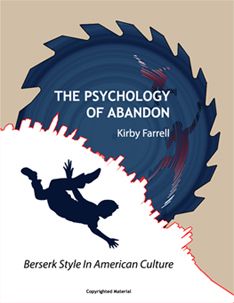
In slang we talk about flipping out, running amok, losing it, etc., Berserk abandon is terrifying yet also alluring, since it promises access to extraordinary resources by overthrowing inhibitions. Berserk style has shaped many areas of contemporary American culture, from warfare and business to politics, sports, and intimate life. Focusing on post-Vietnam America and using perspectives from psychology, anthropology, and physiology, Farrell demonstrates the need to unpack the confusions in language and cultural fantasy that drive the nation’s fascination with berserk style.
<<This book amazes me with its audacity, its clarity, and its scope. We usually think of ‘berserk’ behaviors—from apocalyptic rampage killings to ecstatic revels like Burning Man—as extremes of experience, outside ordinary lives. in fascinating detail, Farrell shows how contemporary culture has reframed many varieties of abandon into self-conscious strategies of sense-making and control.
Abandon has become a common lens for organizing modern experience and an often troubling resource for mobilizing and rationalizing cultural and political action.This landmark analysis both enlightens and empowers us.>>
—Les Gasser, Professor of Information and Computer Science, U. of Illinois, Urbana-Champaigne.

Great leaders, they say, have “magnetism.” Their “charisma” casts a spell. But it’s really a collaboration. Hitler staged the Nuremburg rallies, but thousands had to show up and stand in the hot sun saluting and throbbing with crowd power. They’d been through a capital “D” Depression. They wanted to be rescued. They believed in a payoff. When it comes to leaders, them is us.
So here we are in our own American funk, telling pollsters who we’d like to rescue us. It’s highly scripted. People have been studying leadership formulas at least since Plato. And tycoons have been manufacturing leaders for ages. Yet followers still want to believe.
Consider candidate Trump, who’s a favorite among some voters. Instead of questioning whether he’s a worthy candidate, let’s look at tools he and others—including Hitler—have used. No, this isn’t to equate the two men. We’re talking tools here. And wondering how them could be us.
Let’s start with the obvious. Adolf and Trump play the roles of “Hitler” and “Trump,” heroes powerful as the parents who raise us as infants. Literally, they raise our morale and self-esteem, rousing us to feel heroic purpose, offering us more life. How can one person do all that? For one thing, they speak in abstractions while winking at you, so you can attribute to them qualities dear to your heart. It’s hero-worship. And it’s like the paradox of love: if you fall in love with someone who embodies your most cherished ideals, you’re in love with yourself.
So how can a “Trump” or an “Adolf” raise anybody up? Yes, they show stupendous self-confidence. But how does that pump us up? The trick is to turn depressive flight into invigorating fight. They gather us into a vigilante posse to drive out hated scapegoats. Trump’s scapegoats are “Mexican” immigrants, plain women, gays, and the losers he fires on TV. The blog Glaad describes him throwing victims “under the bus.” His rejects suffer social death. By contrast, Adolf’s losers—Jews, gypsies, Slavs, Commies, quite a list—get the real thing. “Trump” calls for “mass deportation”; Adolf put mass deportation in cattle cars to Auschwitz. But it doesn’t have to be so sensational. People “put down” others routinely—the same verb that describes euthanizing an animal.
The heroic rationale for this aggression is Social Darwinism and eugenics. Since only the fittest survive, you confirm your own merit by getting rid of the unfit. Eugenics would improve “us” by wiping out disease and death. Adolf’s campaign famously characterized Jews as vermin and germs. Trump trooper Rep. Louie Gohmert of Texas vows that “We don’t even know all of the diseases [immigrants carry], and how extensive the diseases are.”
Adolf relied a lot on slave labor. The idea is to drain the losers before disposing of them. Trump has been abusive to labor. But Iowa radio host Jan Mickelson created his own Nuremburg rally on Twitter by calling for undocumented immigrants to become “property of the state” and put into “compelled labor.” When a caller challenged the idea, Mickelson answered, “What’s wrong with slavery?” Even as it rattles the shackles for immigrants, this sort of slave talk points to America’s real slaves, black folks. Substitute “Jews and gypsies” for black Americans, and you’re reading Adolf’s playbook.
Given this sensitive program, “Trump” and “Adolf” have to be unquestionably right. The script calls for both to have infallible intuition and tell truths others are too cowardly or corrupt to utter. They see through journalists, scientists, and what VP and jailbird Spiro Agnew called “pointy-headed intellectuals.” And they never apologize. This enables them to hold demonstrably false ideas without blushing. Like Adolf’s delusions about Jews,Trump’s claims about immigrants don’t square with reality.
The freedom to lie is part of a larger freedom to break the rules that limit ordinary mortals. In The Art of the Deal, Trump brags about deceiving his business partners in Atlantic City. In a PR stop at the Tex/Mex border, “Trump” floated on a cloud of double-talk. Adolf too felt entitled to enjoy what Goebbels called “the big lie.”
To shore up their infallibility, “Trump” and the Führer “double-down” when wrong. Like double-or-nothing gambling, doubling down can be self-intoxicating. Like a Ponzi scheme, illusion requires more and more illusions to keep paying off. Keep it up and you end up in the toybox or the tomb.
When illusions fail, the great leader blames betrayals. For Adolf, defeat in WW1 was a stab in the back; the Gestapo had a full roster of traitors to kill. On a more playful note, “Trump” condemns Sen. McCain for betraying his troops, supporters, and others. But then, if you think that politicians and illegals are secretly undermining the nation, they’re all traitors.
Self-intoxication leads to overreaching. Beginner’s luck lured Adolf into a doomed two-front war. “Trump” begins to imagine that he can control all the vicious chaos in the middle east. Adolf designed triumphal arches and stupendous buildings. As the kids say, speaking for the infant in all of us, Adolf’s monster buildings would be “awesome.” Not to be outdone, “Trump” brags about “his” skyscrapers.
As self-intoxication intensifies, boundaries blur. The actor confuses theater and life. Emergency physiology takes over. More victims died in the last six months of WW2, when the outcome was obvious, than in all the war years before. Survival rage takes no prisoners.
Told about two young followers in Boston who mauled a homeless Hispanic guy and praised Trump to the police, the candidate first said, “That would be a shame.” But he couldn’t resist adding, “I will say, the people that are following me are very passionate. They love this country. They want this country to be great again. But they are very passionate. I will say that.” Of course he was talking about himself too.
This dreamlike response echoes Adolf’s belief that passionate “will” can conquer the world. The idea is that the leader’s superhuman will can rouse enchanted followers to superhuman ambitions. In the ultimate blurring of boundaries, leader and followers imagine that they’re fusing. As in transference—hero worship—the merger of the enchanter and the enchanted creates not problem-solving wits but passionate belief. In reality all is not well, but in the mirror you see a champion.
Superman wears many costumes: politician, priest, lover, parent, celebrity, business executive, and more. In these days of insanely overpaid executives, for example, the formula shows up when the corporate CEO axes “other” employees in lean and mean downsizing, freeing up profits and awesome power for the impressed followers.
“Trump” and “Hitler” didn’t invent the Superman formula. They’re copycats inspiring more copycats. And like rampage killers, Superman copycats try to outdo one another to get noticed. They’re natural extremists—think “mass deportations.” As leaders and followers pump up the Superman dream, the dream is taking control of them, they breathe hot conviction, and salute.
Better not to stick around for the ending.
——————–
Some interesting youtube documentaries about eugenics and “eugenics”:
https://www.youtube.com/watch?t=427&v=c2kV83nPWnM(link is external)
https://www.youtube.com/watch?t=101&v=ufqOe0_pres(link is external)
———————-
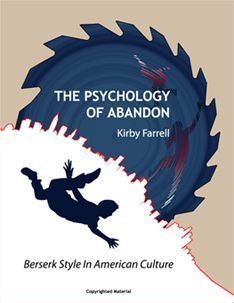
As a cultural style, berserk abandon is terrifying yet also alluring. It promises access to extraordinary resources by overthrowing inhibitions. Berserk style has shaped many areas of contemporary American culture, from warfare to politics and intimate life. Focusing on post-Vietnam America and using perspectives from psychology, anthropology, and physiology, Farrell demonstrates the need to unpack the confusions in language and cultural fantasy that drive the nation’s fascination with berserk style.
<<This book amazes me with its audacity, its clarity, and its scope. We usually think of ‘berserk’ behaviors—from apocalyptic rampage killings to ecstatic revels like Burning Man—as extremes of experience, outside ordinary lives. in fascinating detail, Farrell shows how contemporary culture has reframed many varieties of abandon into self-conscious strategies of sense-making and control.
Abandon has become a common lens for organizing modern experience and an often troubling resource for mobilizing and rationalizing cultural and political action.This landmark analysis both enlightens and empowers us.>>
—Les Gasser, Professor of Information and Computer Science, U. of Illinois, Urbana-Champaigne.


“k1f” Kirby Farrell
A Minnesota dentist has paid tens of thousands of dollars to “hunt” a rhino, an elk, a leopard, and lately Cecil the 13 year old celebrity lion in an African park.
Public opinion is outraged. The “hunt” has the stink of injustice about it. Dentist Walter Palmer hired a guide to bait Cecil out of a protected reserve. The dentist wounded him with his fancy bow, then trailed the dying “king of beasts” for 40 hours till he could finish him off with a bullet. Realizing their mistake, the mighty hunters naturally tried to hide Cecil’s GPS collar and left his severed head behind.
Wildlife authorities in Zimbabwe are making noises abut prosecuting Palmer. His next hunt may be for a shark with a briefcase.
The symbolic logic at work is worth some thought because it’s so prominent in the air these days. To kill a lion, the “king of beasts,” is to kill a mythic predator. The fantasy is that in bagging a “wild” animal, the mild dentist from Minnesota is overpowering “wild” death. The hunter takes nutrition out of the dead prey, but also the animal’s spirit strength. Aztec warriors dressed up in jaguar skins to give themselves a little extra wildcat pick-me-up while killing enemies on the job.
Dentist vs Lion pits two top-dog males in a fight to the death to prove potency and death-defying juju. Conservatives often justify dog-eat-dog survival economics as Social Darwinism, “nature red in [ahem] tooth and claw.”
The public is outraged because the fantasy is such a lie. The rich suburbanite with his store-bought weapons hires a “guide” to whack an elderly tourist lion who’d lost his fear of humans and wore an Oxford University GPS collar. Like drones and sniper wetdreams, it’s shooting fish in a barrel without risk or even a sweat.
In this reading the tame hunter is a sort of murderer, and since he lured the lion out of the park, an assassin. Instead of being an alpha animal, the dentist has used lies and trophy heads the way lynch mobs cut off parts of tortured blacks as souvenirs of their glorious triumph over a “bestial” scapegoat.
Think of the familiar symbolic analogues to the hunt. It’s the child’s triumph over a father, the rebellious subject’s overthrow of the evil king. It’s the fired employee coming back in fatigues and shooting the boss. It’s the alienated schoolkid with a military assault weapon slaughtering schoolmates. For that matter, think of the ISIS hot heads or the Saudigovernment beheading “trophy” POWs (ISIS) and criminals (Saudis) to dramatize superiority.
The “big game” hunt brings trophy glory the way rampage killing spurs global fame. The sleazy dishonesty of Walter Palmer’s ambush tells us how urgent his fantasy had become. But then, think of how the American corporate military played big game hunter in Iraq, slaughtering thousands in a safari that has thrown the entire region into chaos. Propaganda tried to keep the spotlight on the “big predator” Saddam Hussein, who had nothing to do with 9/11, but reality chased that script into the dumpster.
In panic, a sleazy war pulls on a religious helmet. Note the fantasies in “The Marine Rifle Creed”: “My rifle is human . . . We will become part of each other . . . Before God, I swear this creed. My rifle and myself are the defenders of my country. We are the masters of our enemy. WE ARE THE SAVIORS OF MY LIFE. So be it, until victory is America’s and there is no enemy, but peace.”
Forget the bad writing (they’re creating “no enemy but peace”). The creed makes the warrior-hero a quasi-religious figure. It turns the hunt into a sacred crusade so the killers won’t feel so guilty violating the deep prohibitions against killing others. As we see in thePTSD suffering and suicides of vets, it doesn’t always work. Sometimes you just can’t hide the GPS collar and the severed head.
But there’s another fantasy in play too. This summer Americans have been also appalled at the spectacle of cops killing trophy “bad” blacks. As Dylann Roof justified shooting up a Charleston prayer group, black folks are rapists who’d exterminate whites—just as lions are predators. Trapped in his child brain, trying to be a big (ahem) shot, he reasons that it’s kill or be killed.
The point is not that police and a bigshot dentist are conscious racists, but that a constellation of fantasies contribute to their viciousness. The cop who threatened to “light up” Sandra Bland in Texas saw her as a wild animal he had to subdue at all costs. Darren Wilson, the officer who killed Michael Brown reported that he saw Brown as the mythic, wild “Hulk” and felt by contrast like a helpless child.
Such fantasies are exaggerated by the cruel stress in American life that keeps audiences pumped up for nitwit rant broadcasting, Trump and dump meanness, and TV “nature” programming that obsesses over sharks, lions, alligators, and other voracious jaws. I
For a dentist, such jaws can be especially potent, since destists have an unusually highsuicide rate and deal every day with the spectacle of inner human decay. The mouth, after all, focuses the terrifying contradictions of being human. It’s the source of civilized speech, kissing, and taste, but also hides bacteria and rot, not to mention the teeth we use to kill and chew up the bodies of other creatures.
We have to kill and eat or we’d die—again, we’re at once victims and warrior heroes brandishing fine china, knives and forks. We display French cookware on the wall and venerate “cuisine.” But the sneaky reality is that we digest our “prey” into shameful excrement, and then project our angry guilt onto “assholes” and “shitheads.” Dentists charge us a lot of money to look into this frightening paradox every day. Whether they know it or not. Killing “big game” is taking out your fear and rage on a scapegoat, the more shameful when the scapegoat is in effect everybody’s national pet.
A child dresses up as Bwana the great white hunter. If he hasn’t been able to understand the courage it takes to make something healthy out of the fearful human paradox, Bwana the dentist is pitifully trapped in the maw out of which he makes his living.
————
Now available in paperback from Leveller’s Press and Amazon:
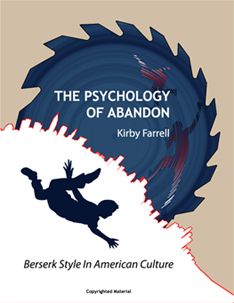
When behavior becomes a cultural style, berserk abandon is terrifying yet also alluring. It promises access to extraordinary resources by overthrowing inhibitions. Berserk style has shaped many areas of contemporary American culture, from warfare to politics and intimate life. Focusing on post-Vietnam America and using perspectives from psychology, anthropology, and physiology, Farrell demonstrates the need to unpack the confusions in language and cultural fantasy that drive the nation’s fascination with berserk style.
<<This book amazes me with its audacity, its clarity, and its scope. We usually think of ‘berserk’ behaviors—from apocalyptic rampage killings to ecstatic revels like Burning Man—as extremes of experience, outside ordinary lives. in fascinating detail, Farrell shows how contemporary culture has reframed many varieties of abandon into self-conscious strategies of sense-making and control.
Abandon has become a common lens for organizing modern experience and an often troubling resource for mobilizing and rationalizing cultural and political action.This landmark analysis both enlightens and empowers us.>>
—Les Gasser, Professor of Information and Computer Science, U. of Illinois, Urbana-Champaigne.


Bill Bornschein is a long-time supporter of the Ernest Becker Foundation who teaches religion and philosophy at St. Xavier High School in Louisville, Kentucky. He graciously agreed to share some of his thoughts and experiences with us regarding teaching Ernest Becker’s work at a high-school level. This is the first in a series of EBF interviews with secondary school teachers about their approaches to Becker conducted by EBF team member Christa Masson. 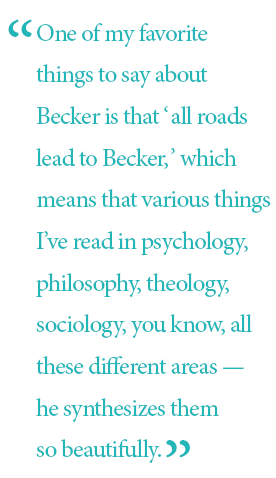
So let’s start with my favorite question to ask- how were you first introduced to Becker?
It was maybe 10 years ago and I was in my local independent video store, Wild and Woolly Video. Wild and Woolly was an amazing place. I noticed the cover of [Flight From Death] and watched the film. I was blown away. One of my favorite things to say about Becker is that “all roads lead to Becker”, which means that various things I’ve read in psychology, philosophy, theology, sociology, you know, all these different areas – he synthesizes them so beautifully. I think I picked up on that right away. Having seen the film I immediately went out and read the book, The Denial of Death, and devoured it. I think the experience that a lot of people have with Becker is this recognition like “Yes, this is it”.
Becker touches on so many topics, what aspects of his work that resonated with you the most?
The work with Kierkegaard and Freud. Contextualizing the two of them in terms with one another was very interesting to me. The thing I like about Becker is that he is so interdisciplinary. If I’m teaching a philosophy class, we can talk about the philosopher Kierkegaard, or if it’s a psychology class we can hit Freud and Rank. If it’s an art class, or something with an art angle, we can get into Otto Rank’s work on the artist … Becker is an amazing platform with which to delve into diverse disciplines.
You mentioned to me earlier that you currently teach a couple of classes and work Becker into the curriculum. How you do this?
Depends on the particular course. For example, this spring I taught a theology and a psychology course. Towards the end of the year I showed the film and broadly talked about these things. Nothing too adventurous there. But first semester I ran a Socratic seminar, which is a particular discussion technique where the goal is not breadth but depth. Instead of doing an overview of Becker, we would take a couple of paragraphs from Denial of Death or Escape From Evil, and then have an in-depth discussion that doesn’t get into the theoretical stuff but really gets to the heart of the existential. That’s something I’m interested in developing and it turns out that next year we are required to teach a sacraments course. One of those is the last rites, or anointing of the sick, so I’ll be working Becker there in a different kind of context. When I do it in philosophy or psychology I don’t usually get into the religious side of things- but that will be unavoidable in a sacraments class. I think I’ll do what I’ve always done- which is locate religion in terms of mythology- break it down structurally and logically. I think Becker, along with a defrocked Catholic priest called Matthew Fox, will breathe some life into it.
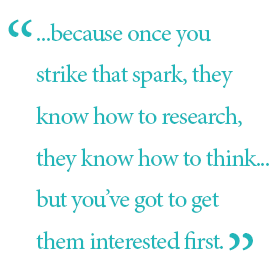 So that was the first time you had done the Socratic seminar? How did the students respond?
So that was the first time you had done the Socratic seminar? How did the students respond?
Generally, they like Socratic seminar because it’s a really dynamic technique. But, there was only one session on Becker and I think that’s actually the key to engaging people with Becker. You’ve got to do so on an existential level where it really hits home, because once you strike that spark, they know how to research, they know how to think… but you’ve got to get them interested first. Part of my philosophy in presenting Becker in all my classes is that I realize it’s going to be an initial exposure. My thought is that they’re going to go to college and there’s a chance they’re going to hear about it again and think “oh, yeah, Becker, that guy Bornschein was always going on about” and maybe they’ll take a more in-depth look at it. That’s the same with any of the contemporary thinkers that I throw out there- it’s giving [the students] the initial exposure so that the next time around it will take on a bit.
Are there ways that work better than others to engage students with Becker?
One of the best things to do is go to cemeteries and basically provide different rituals and exercises to do. We would take one day and go to Cave Hill Cemetery, which is Louisville’s great historic cemetery where Col. Sanders is buried and all the Louisville luminaries. We go there and do a series of exercises and then later in the week we go to Potter’s Field, where people who can’t afford to be buried are taken. On our campus, there is a cemetery for the Xaverian brothers and I’ll have class out there. I get them thinking in different physical settings, getting them out of the classroom.
How have your students responded to Becker?
You get all kinds of reactions to Becker. I mean you get some students who thank you and come back 10 years later to say that “the class meant so much”, but the story that I take heart from is the final temptation of the Buddha. Basically, the devil says “okay, you win, Buddha, you’ve figured it all out… but you know that what you’ve achieved is so far beyond the common man, your words will be twisted.” And the Buddha responds as he touches the earth, “the earth as my witness, some will understand”. I figure if Becker had the wherewithal to put it out there, then as a teacher, I can have the wherewithal to put it out there too. Maybe not everybody’s going to get it but that’s okay. There’s a synergistic power to this stuff.
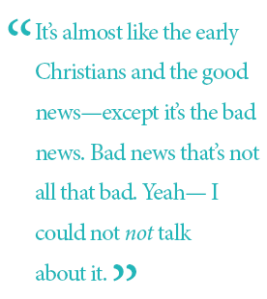 Why did you choose to bring Becker into your work and not just keep it as a work that defines part of your own ideology?
Why did you choose to bring Becker into your work and not just keep it as a work that defines part of your own ideology?
I don’t want to sound like I’m a stark raving true believer or whatever, but I do believe that if you really engage these ideas I don’t know how you can not share them. It’s almost like the early Christians and the good news- except it’s the bad news. Bad news that’s not all that bad. Yeah- I could not not talk about it.
What led you to be a teacher? Did you jump straight into teaching high school?
I come from a family of educators and I think I naturally fell into it. When I was a freshman at University of Louisville, I took a course called “Western Religion and Sexism” and there was this one book called The Great Mother– it was a Jungian style discussion of the archetype. That’s where I got really interested in the study of religion. They didn’t have a degree program so I went to Xavier University in Cincinnati and [studied with] Paul Knitter who was into comparative world religions. I got my undergrad there and my masters at University of Chicago. I came back and got a job at Baden High School in Hamilton, Ohio. I taught there for 5 years and then moved to Louisville and the last 30 years or so I’ve been teaching at St. Xavier, all the time continuing to read and think and philosophize.
If you were going to offer any advice to young educators or those just starting to teach Becker, would there be anything in particular you’d want to tell them?
Well, I guess the first words I’d say would be “thank you”. And I’d suggest to them that they have a good lay of the land in terms of dealing with these issues. I know at the high school level, there have been people that have gotten in trouble because parents are upset with the issues dealt with. You also need to know your students. I always let my kids know where the book is going, not necessarily if we’re doing the Socratic seminar, but if we’re watching the film or going into more depth on Becker, I always try to be sensitive. If you show the film, have it in a situation where they can immediately write down their reactions, hot off the press. Whatever you do with it, they have the raw material. But I always let kids know where we’re going and let them opt out. That’s one way of avoiding that political problem. I have an incredible amount of freedom where I teach; I’ve been there enough that they give me some slack, but you really have to know your situation and your ability to relate to kids. It’s not something I’d go into flippantly. I don’t want to sound discouraging but you need to be aware of what you’re doing. The other thing I’d say is: obviously you can get to Becker from so many different sources. From psychology, from sociology… you could do historical analysis, you could do any kind of social science, so I never worry about presenting Becker in its entirety. I will take pieces and try to spark interest and ultimately leave it up to them to follow up. That’s what I can do where I’m at. I tell them if I have my druthers, I’d teach a whole course on Becker and we’d buy The Denial of Death, but I don’t have that freedom. I make inroads where I can. *to access more of Bill’s recommendations and a list of exercises to perform at a cemetery, visit http://ernestbecker.org/approaching-becker-across-a-high-school-curriculum.html


“Leucocephalus” Phil Hansten
The most costly of all follies is to believe passionately in the palpably not true. It is the chief occupation of mankind. H. L. Mencken
We seem to have an epidemic of absurd thinking. Discussions based on empirical evidence and rational arguments still occur, but they are drowned out by the disputes in which one side has adopted an absurd position—that is, an intransigent stand on an issue in the face of overwhelming evidence to the contrary.
It is absurd, for example, to avoid giving life-saving vaccines to your children. It is also absurd to defend a health care system with per capita costs that are roughly twice that of any other country, yet give results that are inferior to most other developed countries.
It is absurd to claim that unlimited amounts of political donations will not debauch our elections. It is absurd to claim that giving the super-wealthy tax breaks will result in trickle-down to the middle class.
It is absurd to promote gun policies that allow purchase of assault rifles, guns in bars (guns and alcohol… what could possibly go wrong?), and high-capacity magazines. It is absurd to promote a death penalty that does not act as a deterrent, regularly kills innocent people, and costs substantially more than life in prison without parole.
And probably the most chilling absurdity of all is denying the compelling evidence that climate change is largely caused by human activity, and that it represents an existential threat to every person on the planet… including, ironically, the billionaires who are desperately trying to obfuscate the scientific evidence.
We thus have a cadre of state and national politicians who have allowed their self-interest and willful ignorance to distort or deny the empirical evidence on a wide range of issues. They constitute a confederacy of dunces and knaves in a theater of the absurd who are fighting against rational and evidence-based solutions to serious problems.
In the case of climate change they are sabotaging energy policies that are needed to reduce the risk of an unfathomable catastrophe to the human race, one in which the worst-case (but plausible) scenarios suggest that billions of people may perish. Blaise Pascal aptly called humankind the “mindless worm of the earth.” Ironically, by the time we are done destroying the earth, worms may be one of the few life forms left.
What all of these absurdities have in common is that they are on the wrong side of empirical evidence and rational thought. Unfortunately, absurd positions often have the backing of powerful interests or—as with the vaccine avoiders and supporters of capital punishment—they emanate from the pervasive intellectual indolence of the American public.
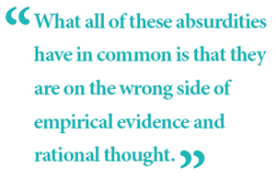 Mere opinions are not inherently misguided, of course. It may be my opinion that chocolate ice cream tastes better than strawberry, and even some moral opinions do not necessarily have an objective and rational basis. I can be for or against gay marriage, for example, without being asked to present any facts about the matter.
Mere opinions are not inherently misguided, of course. It may be my opinion that chocolate ice cream tastes better than strawberry, and even some moral opinions do not necessarily have an objective and rational basis. I can be for or against gay marriage, for example, without being asked to present any facts about the matter.
But the central question is seldom considered: is absurd thinking immoral? Sometimes not. I think we can give a pass to the person who put rectangular (not square) pants on SpongeBob SquarePants or who painted the trucks of the Yellow Truck Company orange (not yellow). I would argue, however, that absurd thinking can indeed be immoral for those in a position to influence public policy. Most of the absurdities discussed above result in a net increase in the deaths of innocent human beings. People who promote public policy based on these absurd positions are no doubt sincere, and consider themselves moral creatures. But I think Pascal was right when he said in his Pensées, “So Let us work on thinking well. That is the principle of morality.” Irrational and counterfactual thinking leading to deaths of our fellow humans is not “thinking well” and it is not moral, no matter how much spin they apply.
One could, therefore, divide public policy debates into three categories: 1) moral questions that do not require much consideration of evidence (e.g., gay marriage, abortion), 2) policy questions that have at least some legitimate arguments and evidence on opposing sides (e.g., education, economic policy), and 3) issues where the empirical evidence has clearly reached the threshold for action, but absurd positions prevail due to predatory self-interest (e.g., climate change) or ignorance (e.g., death penalty). There is hope for correcting absurd positions if they derive from ignorance, such as the death penalty issue, because there is little money supporting the absurd side. For many absurd positions such as those on health care, gun control, and climate change, however, lasting solutions depend on minimizing the overpowering effect of money in politics. It will not be easy, but our very survival may depend on it.